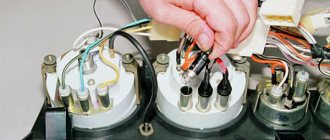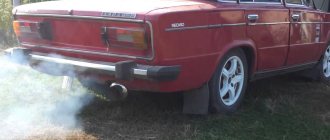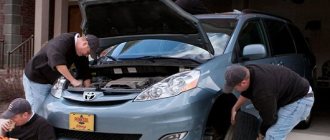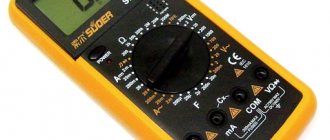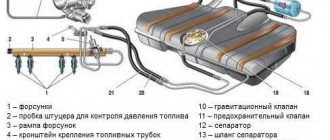This year marks exactly 5 years since AvtoVAZ launched the Lada Vesta into mass production. It became the most talked about car in Russia; the plant really made a good product. But Lada Vesta also has many flaws, shortcomings, and breakdowns. That's why she became so popular. There has never been a car in Russia that was so actively discussed.
Over the course of 5 years, I collected what was improved, what bugs still remain, what broke during this time, all the sores of the car. This does not mean that it has only one shortcomings, just that this is what the review is about. You can find information about the advantages of the Lada Vesta, of which there are also many, in another review.
Suspension
There was a problem with the stabilizer bushings. I suffered for a long time with the creaking, it’s not particularly pleasant to drive over speed bumps. I had to constantly lubricate it, then I installed bushings and brackets from Kia Rio, and forgot about the problem. Now AvtoVAZ has switched to a new type of stabilizer; it took 4 years to correct the jamb.
The suspension is energy-intensive, does not break through, but there is a lot of noise on small bumps (rattling on the left).
Hoses are cracking
The VAZ 127 engine differs from the 126 in another intake module. The new receiver has an additional volume of air and a pneumatic throttle valve, which changes the length of the intake. Increases engine torque at high speeds. This pneumatic system has hoses that, due to their composite composition, become cracked over time.
A characteristic whistle begins to appear in the engine compartment. At the moment, the problem has been solved by installing better hoses.
Engine
The engine sucks. My car still has push-in pistons. In mid-2022, they began to install a plug-free piston from a Turkish company. Now the valve doesn't bend. On my Vesta, it’s 99% that if the timing belt breaks, the pistons will meet the valves.
You can often see oil leaking from under the valve cover in the 4th cylinder. Knocks from the piston group are heard. The 1.8 engine has a large oil burn. 1.6 also has it, but not everyone has it. There is a lot of discussion about the jerkiness of the 1.8 engine, they often change the firmware in order to somehow get rid of the problems. Many people place rubber rings under the adsorber tube.
In 2015-2016 there were problems with timing belts that broke due to jamming of the tension rollers. Dealers at car dealerships had to work hard to replace belts and repair heads under warranty. This problem is now being fixed.
Oil getting into spark plug wells
As a result of work on the shortcomings, the VAZ 16-valve engine was made reliable. Now he doesn't cause any serious trouble. A plugless piston is installed, you can forget about the consequences of a broken timing belt.
But there was one fault remaining in the cylinder head. Owners periodically encounter it.
The head consists of 3 parts:
- Valve lid.
- Camshaft bearing housing.
- Main building.
All parts are joined together using sealant. Over time, the sealing layer is washed out, and oil begins to flow into the spark plug wells. This can be seen when replacing spark plugs if you remove the individual ignition coils. The problem is solved by disassembling the head and applying a new layer of sealant.
Engine compartment
Here you can note the wiring that is carried out openly, without protection. Also, the coils themselves quickly fail. I recently had one replaced under warranty.
The washer reservoir is noisy when there is some fluid left in it. It starts to gurgle, you can hear it in the cabin, the problem has not been fixed.
The hood often knocks, you have to constantly adjust it. Sometimes the limit switches freeze and the light comes on in the cabin. The electronics “think” the hood is open.
Transmission noise
A noise is heard from the gearbox, a small knock that disappears when you press the clutch pedal.
There are 2 misconceptions:
- The release bearing hummed. But it shows itself only at the moment the pedal is pressed, when the load on the clutch bearings begins.
- The input shaft bearing is humming. This is also incorrect, since SKF bearings have been installed on VAZ boxes for many years. There is practically no marriage on them.
In fact, the culprit of the knock is the clutch driven disc, namely its central bushing.
It has play in the seat. During torsional vibrations at idle, a fractional knock appears. The problem is solved by installing new clutch discs.
Transmission
I have a VAZ gearbox with a 1.6 engine and it howls. Buyers, having read owner reviews about problems with the gearbox and its noise, often choose other cars. The gearbox is filled with semi-synthetic, but I use synthetics. If there is severe frost, the semi-synthetic lubricant freezes. Oil may also be squeezing out from under the gasket. Otherwise the box is reliable.
The robot also had problems, different firmware was released, it got better. But still, people are reluctant to take a Lada Vesta with a robot. Now they are installing a Japanese variator.
Why I don’t want to buy a Lada Vesta, but drive a Kalina
The clutch also quickly failed, since the car is heavy, especially the SV Cross (1300 kg). The clutch discs were getting very hot.
Weaknesses of Lada Vesta
Lada Vesta has been produced at AvtoVAZ facilities since November 2015. The article selects all the weaknesses of Vesta that have been identified by car owners at the moment. The line of power units consists of three gasoline engines: 11189, 21129, HR16DE-H4M. The latter is an imported engine produced by the Renault-Nissan alliance. It is installed on such Nissan car models as: Note, Qashqai, Juke, Tiida. The total share of Russian-made spare parts is 20%. Reviews from West owners speak positively about the car, but there are still some shortcomings that may await you soon after purchase and active use.
Our infographics contain the most current and most common Vesta diseases, so this information will help owners of the new model prepare for possible problems and find out the weak points of the Lada Vesta.
Chassis:
A very common problem is weak stabilizer links . The problem was noticed on the first Lada Vesta. Literally after 3 thousand kilometers they begin to tap. There is also the creaking of stabilizer rubber bands on smooth metal when moving over bumps. The creaking is eliminated under warranty by sanding the smooth surface of the metal with sandpaper. AvtoVAZ argues this problem is a bad supplier, which has already been replaced by a supplier of better quality racks.
At a mileage of 30 thousand km, play may appear in the lower bearings of the steering knuckle . Subsequently, AvtoVAZ eliminated the play of the ball joint by changing the liner housing, which also simultaneously solved the problem of squeaks when turning the wheels.
Factory alloy wheels are so weak that they bend when the wheel gets into even a small hole, which is why you can often hear them called “paper”.
Transmission:
Errors in the automatic transmission algorithm , the automatic transmission can be thoughtful at times, and “nodding” occurs when changing gears. The reason for this is a glitch in the first firmware. It can be solved by reflashing it from an official dealer. As for the manual transmission, the situation is better; only on some of the first Vestas with manual transmission do difficulties appear in shifting gears .
After 15,000 km, on some manual gearboxes from Renault (JH3), the bearing began to howl, and 1st, 2nd and 3rd gears were difficult to engage (the rod blocking block stuck in its hole).
Salon:
Cricket behind the instrument panel . It can be eliminated quite easily by removing the panel and installing sealing materials under the creaking plastic.
The paint on the steering wheel lining wears off quickly . Moreover, even after a warranty replacement, abrasions quickly appear.
At 4th or 5th speed of the heater fan, vibration appears on the steering wheel . This is due to contamination of the impeller. By the way, in the cars of 2022, this problem was not solved in Vesta.
The trim on the rear doors is coming off .
There is a knocking sound from the cables under the side door trim. It can also be easily removed by fixing them. All these problems concern the first releases of Vesta; most likely, they will be corrected in the future, because as practice shows, AvtoVAZ reacts quite quickly to emerging childhood problems.
Electronics:
Multimedia glitches , there are many complaints that when AUX mode is running on the multimedia system, a black screen appears when the rear view camera is turned on. Or the multimedia does not start at all unless you do a hard reset. Most likely this is also a temporary problem with the first machines, which will be eliminated with new firmware.
There are also cases of the heated windshield not working. Possible reasons: either the firmware or the fuse (there are two of them).
The ignition coil was noticed to fail (on cars from the first batch), it was replaced under warranty.
Door limit switches begin to fail at 20 thousand mileage.
Body:
When driving around 3 thousand km, when using standard frame wipers, scratches appear on the windshield . Here it’s like on old VAZs - “buy a new car and immediately change the wipers.” The case is under warranty and the official dealer will replace the glass.
The front and rear bumpers suffer greatly from chips and scratches, and the paint on it begins to peel off along with the varnish.
Another common drawback of Vesta is that the velvet covers fit too tightly to the side windows. If sand gets in and you still use the power windows, scratches will form on the side windows , the appearance of which is accompanied by a squeaking sound. The official instructions from AvtoVAZ in this case are to cut off two sides of the seal.
There have been cases of dirt accumulating under the hood due to the absence of a section of the hood seal in the lock area . Dirt not only spoils the appearance, but is also harmful to engine compartment devices, such as the generator, belts, electricians, and the like. This problem is relevant for the Lada Vesta of the first releases. Can be cured by installing another seal.
And after six months of operation, the door hinges may begin to creak, naturally, after lubrication everything goes away, but the very fact that the factory lubrication is not enough for a long time is a little upsetting.
Headlights:
The headlights themselves are fine, but for some reason the turn signals on the side rearview mirrors
Exhaust system:
After 30 thousand km, the rubber bands securing the muffler begin to sag and these “carrots” simply break.
Breaking off of brackets on the exhaust exhaust pipe - steel nuts were used instead of brass.
What changes have been made to Vesta cars produced in 2016 and 2022?
These are, in principle, all the problems that a car can suffer from. Yes, it is damp and expensive when compared with Rio and its other Korean brother Solaris, but they also had many shortcomings in their time, which, by the way, the manufacturer was in no hurry to eliminate. But no one could imagine that a new VAZ car would have only a couple of “childhood diseases”, each of which can be easily and inexpensively eliminated.
Summary
To summarize, we can say that despite the minor shortcomings of the Lada Vesta, the car as a whole turned out great. There is good handling, excellent design, good ergonomics and a good landing, in which severe fatigue is not noticed even on long trips. Most likely, the identified problems with the Lada Vesta will be eliminated in the future. After all, each car produced has a personal manager attached to it. If you contact him, a technical inspection will be promptly organized by an official dealer. Each detected case of Vesta malfunction is documented, then data on the breakdown is sent to the manufacturer for elimination in subsequent production. The car is new in every sense of the word, so the article will be updated as new problems arise. You can help us make this article better. Leave any problems you notice with the Lada Vesta in the comments.
Salon
There were problems with 2-din radios - connecting to the phone, navigation maps. Then AvtoVAZ released new firmware, the questions went away.
Control unit for the stove and air conditioner - it is difficult to set a comfortable temperature. It turns out to be either hot or cold.
The cup holders are small and cannot hold a normal bottle. The seat belt buckles are low and difficult to use. Now they have been lengthened, it has become normal. I don’t really like the armrest, the box is small, you can’t put anything in it except a wallet. Made with some kind of magnets, not adjustable, the height is inconvenient.
The build quality in the cabin is not up to par. Lada Vesta is considered a budget car, although luxury trim levels already reach 1 million rubles. For example, a car with a CVT costs 980 thousand rubles.
Gili Emgrand 7 with CVT - Lada Vesta killer
There were creaks in the cabin, some of them have been fixed, for example, in the glove compartment area. But there are still noises. The door handles inside squeak. Lots of screws and self-tapping screws not covered with plugs.
Unreliable outdoor antenna
Vesta is equipped with 2 types of antennas for the standard multimedia system:
- Regular.
- In the form of a shark fin (on the “cross” and “sport” versions).
The first type is characterized by a defect - during operation, the body disassembles itself. The upper part flies off while moving. On the latest releases, only fin antennas are installed.
Electric booster
Among the latest jambs, one can note knocks in the EUR. The question is that the Kaluga electric amplifier is being installed, which was previously installed on Kalinas and Grants. Then they stopped installing them because they were knocking and glitching. After this, AvtoVAZ switched to Korean electric amplifiers. Kaluga EURs were again installed on the Lada Vesta, citing the fact that the problems had been eliminated. But in fact, the issues are not resolved, there were glitches on my machine. Others experience a knocking sound.
Modification of the Lada Vesta to replace the cabin filter
I have collected such shortcomings and sores on the Lada Vesta over the 5 years that I had it, and some of them still remain. Have a good mood, good luck on the roads!
The exhaust corrugation is rusting
Domestic cars have always had a short-lived exhaust system, and Vesta was no exception, where the corrugation rusts very quickly. At first, nothing gives this away, the sound is quite familiar, but soon the roaring car ends up being serviced. This may happen within the warranty period, so do not miss the opportunity. It is interesting that in the first years of Vesta sales, the corrugation was covered by a warranty of only 35 thousand km or a year, but after criticism it was made standard: 100 thousand km or 3 years.
